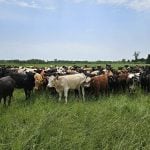Knowing your forage quality and quantity, as well as animal weight and body condition, is crucial in strategically meeting animal nutritional requirements with low-cost winter-feeding programs.
“Forage quality is always important for livestock producers,” says Grant Lastiwka grazing/forage/beef specialist, Alberta Agriculture and Rural Development, Olds. “With high grain prices, the alternative of adding grain to a livestock ration is costly. By having high-quality forage, grain is usually not needed in mature-animal maintenance rations.”
Lastiwka notes that the exceptions to this are thin animals, early winter calving programs, really cold weather, or after lactation starts.
Read Also

Farming Smarter receives financial boost from Alberta government for potato research
Farming Smarter near Lethbridge got a boost to its research equipment, thanks to the Alberta government’s increase in funding for research associations.
“For growing animals, if forage quality is excellent, a forage-only diet can give reasonable performance for replacements, backgrounders going to grass in the spring, and maintenance of first- and second-calving cows. Depending on calving date, body condition, wind shelter and bedding, high-quality forage may be all the animals need in the last trimester, or even after calving.”
Winter temperatures need to be about -20 to -25 C (including wind chill) before an animal in good body condition will have problems. Thinner animals are stressed sooner and -15 C may be their low critical temperature.
Lastiwka recommends Alberta Agriculture’s website as having good articles on winter feeding nutrition and on determining forage quality. These articles can be found at http://www1.agric.gov.ab.ca/$department/deptdocs.nsf/all/inf6663#nutrition
“The Foragebeef.ca website is another excellent resource,” says Lastiwka. “This site was developed in Canada and is managed daily by two of Alberta Agriculture and Rural Development’s beef and forage specialists.”
Lastiwka also recommends a new YouTube video the department has produced on how to get a proper forage sample. It is available at http://www1.agric.gov.ab.ca/$department/deptdocs.nsf/all/info13409
“Remember that forage quality is only part of the story,” adds Lastiwka. “Quantity consumed is the other more important factor in determining if animal nutrient requirements are met.”














